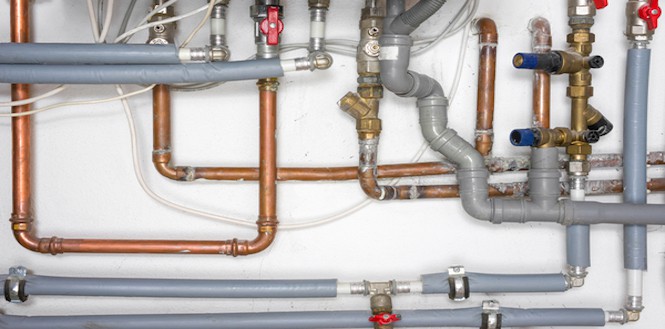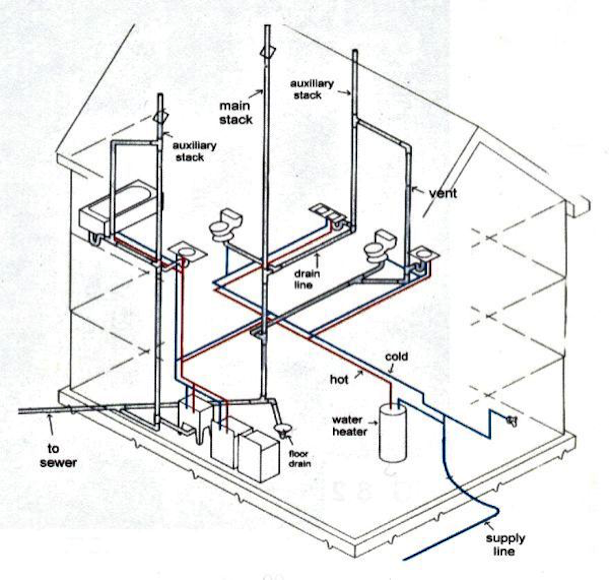The Design of Your Home's Plumbing System Explained
The Design of Your Home's Plumbing System Explained
Blog Article
Each person has got their personal piece of advice on the subject of Anatomy of a House: Understanding the Components.

Recognizing just how your home's plumbing system works is essential for every single property owner. From providing clean water for alcohol consumption, cooking, and showering to safely removing wastewater, a properly maintained pipes system is critical for your household's health and convenience. In this extensive guide, we'll discover the intricate network that comprises your home's plumbing and deal suggestions on maintenance, upgrades, and dealing with typical issues.
Introduction
Your home's plumbing system is greater than just a network of pipelines; it's a complicated system that ensures you have accessibility to clean water and efficient wastewater elimination. Knowing its elements and how they collaborate can help you protect against pricey repair services and ensure everything runs smoothly.
Fundamental Components of a Plumbing System
Pipelines and Tubing
At the heart of your plumbing system are the pipelines and tubing that lug water throughout your home. These can be made of numerous products such as copper, PVC, or PEX, each with its benefits in regards to toughness and cost-effectiveness.
Fixtures: Sinks, Toilets, Showers, etc.
Components like sinks, bathrooms, showers, and tubs are where water is used in your house. Understanding how these components link to the pipes system aids in detecting problems and intending upgrades.
Shutoffs and Shut-off Factors
Shutoffs manage the flow of water in your plumbing system. Shut-off valves are vital throughout emergency situations or when you need to make repair services, enabling you to isolate parts of the system without interfering with water flow to the entire house.
Water Supply System
Main Water Line
The major water line connects your home to the community water system or a personal well. It's where water enters your home and is distributed to various fixtures.
Water Meter and Pressure Regulatory Authority
The water meter measures your water usage, while a stress regulator guarantees that water moves at a safe stress throughout your home's plumbing system, avoiding damage to pipes and components.
Cold Water vs. Warm water Lines
Understanding the difference between cold water lines, which provide water directly from the main, and warm water lines, which carry warmed water from the hot water heater, assists in fixing and preparing for upgrades.
Drainage System
Drain Pipes Pipeline and Traps
Drain pipelines carry wastewater away from sinks, showers, and toilets to the sewage system or septic system. Traps avoid drain gases from entering your home and also catch particles that might trigger obstructions.
Ventilation Pipes
Ventilation pipelines allow air into the drainage system, avoiding suction that can slow water drainage and create traps to empty. Proper ventilation is crucial for keeping the honesty of your plumbing system.
Significance of Appropriate Water Drainage
Ensuring proper drainage protects against backups and water damages. On a regular basis cleansing drains pipes and preserving traps can prevent costly repair work and extend the life of your plumbing system.
Water Furnace
Types of Hot Water Heater
Water heaters can be tankless or conventional tank-style. Tankless heaters warm water on demand, while storage tanks store warmed water for prompt use.
Exactly How Water Heaters Link to the Pipes System
Recognizing exactly how water heaters link to both the cold water supply and warm water circulation lines assists in identifying issues like not enough hot water or leakages.
Upkeep Tips for Water Heaters
Routinely purging your water heater to eliminate sediment, examining the temperature level setups, and examining for leakages can prolong its lifespan and improve power effectiveness.
Usual Plumbing Issues
Leakages and Their Causes
Leakages can happen due to aging pipelines, loosened fittings, or high water stress. Attending to leakages promptly stops water damage and mold and mildew development.
Obstructions and Clogs
Obstructions in drains pipes and toilets are usually triggered by flushing non-flushable items or an accumulation of oil and hair. Utilizing drain displays and bearing in mind what goes down your drains can protect against clogs.
Indicators of Pipes Troubles to Watch For
Low tide stress, slow drains, foul odors, or abnormally high water expenses are signs of prospective pipes problems that should be resolved quickly.
Pipes Maintenance Tips
Routine Evaluations and Checks
Set up annual plumbing evaluations to capture concerns early. Seek indications of leakages, rust, or mineral accumulation in taps and showerheads.
DIY Maintenance Tasks
Simple tasks like cleaning tap aerators, looking for commode leaks making use of dye tablets, or insulating exposed pipelines in cold climates can prevent major pipes issues.
When to Call a Specialist Plumbing
Know when a plumbing problem calls for professional experience. Attempting intricate fixings without proper expertise can bring about more damages and higher repair service expenses.
Updating Your Plumbing System
Factors for Updating
Updating to water-efficient fixtures or replacing old pipes can enhance water high quality, decrease water expenses, and enhance the value of your home.
Modern Plumbing Technologies and Their Benefits
Check out modern technologies like wise leakage detectors, water-saving commodes, and energy-efficient hot water heater that can save cash and decrease ecological impact.
Cost Considerations and ROI
Calculate the in advance costs versus lasting savings when thinking about plumbing upgrades. Several upgrades spend for themselves with decreased energy bills and fewer repair work.
Environmental Effect and Preservation
Water-Saving Fixtures and Appliances
Setting up low-flow faucets, showerheads, and toilets can considerably reduce water use without sacrificing efficiency.
Tips for Lowering Water Usage
Basic routines like taking care of leaks promptly, taking shorter showers, and running complete tons of laundry and dishes can preserve water and reduced your utility expenses.
Eco-Friendly Plumbing Options
Take into consideration lasting pipes products like bamboo for floor covering, which is durable and environment-friendly, or recycled glass for counter tops.
Emergency Readiness
Actions to Take During a Pipes Emergency situation
Know where your shut-off valves lie and just how to switch off the water in case of a burst pipe or significant leak.
Relevance of Having Emergency Contacts Convenient
Maintain contact details for neighborhood plumbers or emergency solutions conveniently offered for quick reaction throughout a pipes situation.
DIY Emergency Fixes (When Applicable).
Momentary solutions like utilizing air duct tape to patch a leaking pipe or positioning a container under a dripping tap can reduce damage until a professional plumber shows up.
Conclusion.
Understanding the anatomy of your home's plumbing system empowers you to maintain it properly, conserving money and time on fixings. By following routine upkeep regimens and staying notified regarding modern-day plumbing modern technologies, you can guarantee your pipes system operates efficiently for several years to find.
HOW YOUR PLUMBING SYSTEM WORKS
Which Pipes Do What?
Blue lines = fresh water supply entering the building
Red lines = hot water supply entering the building
Grey lines = pipes carrying waste away from the building and venting pipes carrying gases away from the building (through the roof)
YOUR MAIN PLUMBING SYSTEMS
There are two main plumbing systems that support your home s basic plumbing needs one that brings clean water into your home, and one that sends dirty water away from your home. Connected to the toilet, bath, shower, and other faucets in your home, these two systems keep your water flowing in the right directions.
ACCESSING FRESH WATER
Fresh and clean water is brought into your home through the main water supply line . Filtered through one pipe, this water is pressured to flow into the various fixtures in your home at any given time.
This water can be sourced from a well located on your property, a pond or river (mostly cottages), or, as in most cases, from the city s municipal water treatment centre. However, it is important to note that water that is untreated, such as the water siphoned from ponds or rivers, may not be safe to drink. Personal water supplies always need to be treated for hardness and contaminants before consumed.
MUNICIPAL WATER SUPPLIES
Improve taste and odour
Remove sediment
Eliminate hardness
Reduce chlorine
COLD WATER SUPPLY VS. HOT WATER SUPPLY
Cold water flows into your home or building through the service line, which then distributes hot or cold water to your fixtures. This line is most commonly run through a central column that runs floor to floor. Hot water runs in short and straight pipes as the longer the pipeline, the more heat that will be lost in the transfer. Having shorter pipes also allows residents to access hot water more quickly.
WASTE WATER SYSTEM
Your wastewater system is divided into two parts pipes that send wastewater away from your home and venting pipes that send sewer gas away from your home. Sewage water travels through pipes that flush the water and waste towards local sewers that are operated and managed by your city or town. Most sewer systems rely on gravity to move the wastewater to where it needs to go.
The further away from your toilet or sink, the larger wastewater pipes become. This allows for waste to be disposed of from various parts of your home or business at once without pipe blockages. The angle and flow of these pipes are also essential for keeping your waste pipes clear of build up.
https://harrisplumbing.ca/how-your-home-plumbing-system-works/

HOW YOUR PLUMBING SYSTEM WORKS
Which Pipes Do What?
YOUR MAIN PLUMBING SYSTEMS
There are two main plumbing systems that support your home s basic plumbing needs one that brings clean water into your home, and one that sends dirty water away from your home. Connected to the toilet, bath, shower, and other faucets in your home, these two systems keep your water flowing in the right directions.
ACCESSING FRESH WATER
Fresh and clean water is brought into your home through the main water supply line . Filtered through one pipe, this water is pressured to flow into the various fixtures in your home at any given time.
This water can be sourced from a well located on your property, a pond or river (mostly cottages), or, as in most cases, from the city s municipal water treatment centre. However, it is important to note that water that is untreated, such as the water siphoned from ponds or rivers, may not be safe to drink. Personal water supplies always need to be treated for hardness and contaminants before consumed.
MUNICIPAL WATER SUPPLIES
COLD WATER SUPPLY VS. HOT WATER SUPPLY
Cold water flows into your home or building through the service line, which then distributes hot or cold water to your fixtures. This line is most commonly run through a central column that runs floor to floor. Hot water runs in short and straight pipes as the longer the pipeline, the more heat that will be lost in the transfer. Having shorter pipes also allows residents to access hot water more quickly.
WASTE WATER SYSTEM
Your wastewater system is divided into two parts pipes that send wastewater away from your home and venting pipes that send sewer gas away from your home. Sewage water travels through pipes that flush the water and waste towards local sewers that are operated and managed by your city or town. Most sewer systems rely on gravity to move the wastewater to where it needs to go.
The further away from your toilet or sink, the larger wastewater pipes become. This allows for waste to be disposed of from various parts of your home or business at once without pipe blockages. The angle and flow of these pipes are also essential for keeping your waste pipes clear of build up.
https://harrisplumbing.ca/how-your-home-plumbing-system-works/
As an avid person who reads about Plumbing Installation 101: All You Need to Know, I thought sharing that piece was important. Don't hesitate to take a moment to distribute this post if you enjoyed it. Thanks for being here. Revisit us soon.
Click Here Report this page